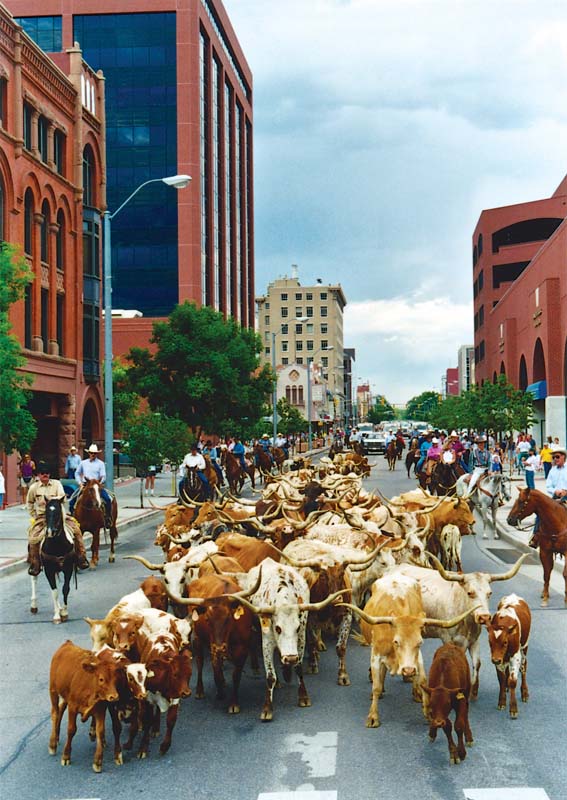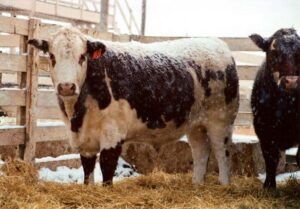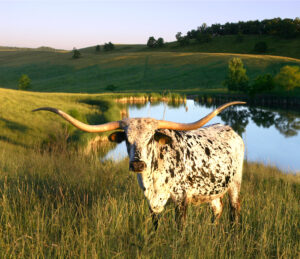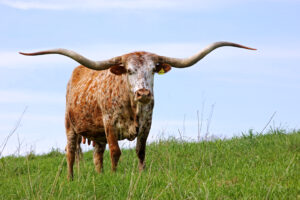Texas Longhorns: Foundation of the American West

Why is America’s oldest cattle breed attracting so much interest? The answer is revealed, in part, in the fascinating history of these genetically unique cattle.
On his second voyage to thee Americas. Christopher Columbus landed long-horned Spanish cattle in January of 1494 Descendants of these ocean voyagers were the first cattle populate North America.
Of those first cattle loosed on the shores of the Americas, a few strayed or were abandoned. And, over the centuries, those with the ability to survive multiplied from isolated bands to literally millions! Thus was created the Texas Longhorn, imported North America by Spanish explorers. then refined by nature, tested by the crucible of time and the elements Hard hooves and lethal horns equipped them for survival. Their spectacular color variations reflected the three types of cattle originally introduced from Spain the predominately red “Retinta” and the white and black breeds of Andalusian cattle.
Until the mid-1800″ these big horned, rugged cattle multiplied without the help of man. Traits were genetically “fixed” as result of survival of the fittest, resulting in ecologically adapted bovine families with extremely good health, fertility teeth, disease resistance, and soundness of body and limb.
In 1865. official estimates placed the Texas Longhorn population between 3,000 000 and 4,000,000 head. These wild, nature developed cattle provided cash for their captors. By 1889 an estimated 10,000,000 head of Longhorns had been trailed was North, West and East out of Texas Converting wild cattle into gold were well suited the ultimate struggle; one to which the “Texas cattle” were well suited. Longhorns could walk amazing distances, living off the land, protecting themselves, swimming rivers, surviving desert heat and winter snow. From this clash between men, animals and the environment grew the world-famous legends of the American cowboy.
In 1876, an estimated 1,000 head breeding herd was introduced into southern Alberta. Canada. By 1884. these cattle were estimated to have multiplied to 40,000 head including additional importations. In 1900, the U.S. Department of Agriculture estimated the U.S. cattle population at 60,000.000 most of which contained a percentage of Texas Longhorn blood.
In the early twentieth century, purebred cattle breeds from Europe and Asia became available to fill the desires of consumers. The foundation stock of purebreds in this country were “bred up” from a native Longhorn base. Because of the excellent growth and vitality resulting from the hybrid vigor (heterosis) of the Longhorn-cross, this breeding process became so popular that pure Texas Longhorn blood was nearly eliminated. Another factor in the Longhorn near-C disappearance was the breed’s unique natural lean meat.
Candles had been the world’s chief source of light for over 2,000 years. Tallow, the main ingredients candles, obtained by rendering animal fat. Soaps, lubricants and cooking also requires tallow “Hide-and-tallow” companies, as early beef processing plants were known, were major industry 1n the early days of the industrial revolution. Prior to the advent of refrigeration, meat was essentially by-product. The demand for tallow and hides was the driving force of the cattle business and genetics were selected for the heaviest tallow-producing animals. It is no wonder that the naturally lean Longhorn, with 08 percent less renderable tallow than English breeds, was not in demand.
By 1930, most open range was fenced and southwestern cattle barons zeroed in on the favorite breeds of “fat” cattle. The historic Texas Longhorn was the time-tested choice of only a few serious cowmen. Several early producers were instrumental in providing Longhorn genetics when the U.S. Government herd was established in 1927 at the Wichita Mountains Wildlife Refuge at Cache, Oklahoma.
During the past half-century, a pattern of seven differentiated families’ or bloodlines emerged and has been perpetuated by some Longhorn breeders. Today, producers of Texas Longhorns either raise their favorite family bloodline in a pure state or mix and select combinations of several of these bloodlines Longhorns are famous for their long life span. Many cows live and calve regularly up to and past 20 years of age, occasionally producing for 25 or 30 years. In commercial terms, this longer life span means the rancher can retain fewer replacement heifers to maintain herd size, allowing him to market more calves annually. Many professional ranchers are finding that Texas Longhorn influence can increase the productive life span by several years over conventional beef breeds.
 Ten of the 20 largest ranches in the West have successfully used Texas Longhorn bulls to calve heifers. The Texas Longhorn bull’s reputation for the easy and uncomplicated birth of a vigorous calf is undisputed among knowledgeable ranchers of North America, The tall, lean Longhorn shape with narrow head and shoulders make first birth for begging mother a far less traumatic experience. The U.S. Meat and Animal Research Center of Clay Center, Nebraska, has tested this old breed’s modern qualities. Their Germ Plasm Evaluation Program, Cycle IV Phase 2, evaluated 1,905 births comparing 11 breeds. The Texas Longhorns proved superior, with the highest unassisted birth rate of all breeds (99.7%) and the lowest birth weight (71.3 1bs.). These old, nature-fixed, time-tested qualities are making extra profits available for professional ranchers through reduced labor and more live, saleable calves. These low stress birth traits in Texas Longhorn-sired calves continue to profit owners when the mother cow quickly “breeds back” after an easy birth.
Ten of the 20 largest ranches in the West have successfully used Texas Longhorn bulls to calve heifers. The Texas Longhorn bull’s reputation for the easy and uncomplicated birth of a vigorous calf is undisputed among knowledgeable ranchers of North America, The tall, lean Longhorn shape with narrow head and shoulders make first birth for begging mother a far less traumatic experience. The U.S. Meat and Animal Research Center of Clay Center, Nebraska, has tested this old breed’s modern qualities. Their Germ Plasm Evaluation Program, Cycle IV Phase 2, evaluated 1,905 births comparing 11 breeds. The Texas Longhorns proved superior, with the highest unassisted birth rate of all breeds (99.7%) and the lowest birth weight (71.3 1bs.). These old, nature-fixed, time-tested qualities are making extra profits available for professional ranchers through reduced labor and more live, saleable calves. These low stress birth traits in Texas Longhorn-sired calves continue to profit owners when the mother cow quickly “breeds back” after an easy birth.
Modern, high-tech cattle production methods also seem have deviated from the proven economic traits of the Texas Longhorn. Many animal scientists and cattlemen feel that most “modern cattle” are too big, too fat, and shaped wrong for easy birthing and lack disease resistance and longevity. To correct these trends, several exciting new synthetic breeds using Texas Longhorn blood have been developed. The *El Monterey,’ “Salorn” and “Geltex” are established, and others are in various stages of development.
 These synthetic breeds are testing, scientifically, various percentages of Texas Longhorn blood to develop an optimum range animal to meet the changing demands of today’s consumer. These new Texas Longhorn synthetic breeds are excelling in producing Choice carcasses with a very high percentage of Yield Grades 1 and 2. The Texas Longhorn’s lack of fat, once a cause of near-extinction, is now recognized as one of the breed’s strong qualities. Heath conscious modern nutritionists consistently condemn the heavy fat content of some beef and whole heartedly support the use of less fat, lower cholesterol meats like the Texas Longhorn Research at Oregon State University found that Texas Longhorns are highly immune to the deadly tansy ragwort plant which plagues the northwestern cattle industry. lowa State University found Texas Longhorns to be highly resistant ordinary bovine bloat. The Longhorn’s virtual immunity pinkeye, another expensive malady, is also well-documented.
These synthetic breeds are testing, scientifically, various percentages of Texas Longhorn blood to develop an optimum range animal to meet the changing demands of today’s consumer. These new Texas Longhorn synthetic breeds are excelling in producing Choice carcasses with a very high percentage of Yield Grades 1 and 2. The Texas Longhorn’s lack of fat, once a cause of near-extinction, is now recognized as one of the breed’s strong qualities. Heath conscious modern nutritionists consistently condemn the heavy fat content of some beef and whole heartedly support the use of less fat, lower cholesterol meats like the Texas Longhorn Research at Oregon State University found that Texas Longhorns are highly immune to the deadly tansy ragwort plant which plagues the northwestern cattle industry. lowa State University found Texas Longhorns to be highly resistant ordinary bovine bloat. The Longhorn’s virtual immunity pinkeye, another expensive malady, is also well-documented.
In a test of 11 breeds conducted by the U.S Meat Animal Research Center, Texas Longhorn-sired calves graded USDA Choice 62%, a ration of 104.2% compared to the all-breed test average. Longhorn-sired steers in this test had 61.7% dressing percentage with an 81/8% ratio of fat thickness comparison. The Texas Longhorn-sired steers had an average fat thickness of 0.36″ as compared with an average of 0.44″ for the other 10 breed groups. In scientific carcass evaluations, which will determine the future direction of the red meat industry, the Texas Longhorn competitive their nature-produced unique, due strength over all other breeds anatomy and physiology. The National Western Stock show in Denver. established the first and largest carcass evaluation in the world of pen five 3/4-blood Texas Longhorn steers won Reserve Champion against all breeds with back fat ranging from 0.15″ to 0.30″ Yield grade ranged from 1.75 to 2.42 with rib-eye measurements over 13 square inches.
At the 1987 National Western, CO six-steer Texas Longhorn cross entry placed Second in the heavyweight steer division. These steers averaged 0.41″ back fat, after 105 days on feed. The steers weighed in at 1.197 lbs. and had an average of 14 sq. inches of ribeye, a cutability of 51.4% and Yield Grade 2. A prime grade steer from this group was the highest indexing prime grade animal for two years in a row. The following year Longhorn crosses placed one First, two Seconds, and a Third against world-class competition.
 On the West Coast, 1st place in the Group Carcass category of the 3rd Annual California Steer Futurity at California Polytechnic Institute was won by Texas Longhorn crosses. Of a total of 240 steers, entered by 23 ranches, the Longhorn cross’ 108.8 index was the best recorded. The winning steers started on feed at an average weight of 687 Ibs. and after 110 days they finished at 1,052 Ibs. with a 3.40 1b. average daily gain. The average carcass weighed 639.6 lbs. with a 62% dress on a quality average of Choice-minus, Yield Grade 2. The back fat averaged 0.33″ and the rib-eye area average was 11.50 square inches. The Longhorn group also led the conversion rate with feed required per pound of gain. Christopher Columbus must be credited with some real foresight to have selected cattle which could produce nearly 500 years of off-spring, pull thousands of wagons over the Oregon Trail, set the stage for the creation of the legendary American cowboy and still play a prominent role in producing cutting-edge quality, lean nutritional food for coming 21st century. Indeed, the once-unappreciated Texas Longhorn has earned the respect not only of those who love history, but those of professional ranchers who are laying claim to the future. The old breed is front and center- in a high tech world.
On the West Coast, 1st place in the Group Carcass category of the 3rd Annual California Steer Futurity at California Polytechnic Institute was won by Texas Longhorn crosses. Of a total of 240 steers, entered by 23 ranches, the Longhorn cross’ 108.8 index was the best recorded. The winning steers started on feed at an average weight of 687 Ibs. and after 110 days they finished at 1,052 Ibs. with a 3.40 1b. average daily gain. The average carcass weighed 639.6 lbs. with a 62% dress on a quality average of Choice-minus, Yield Grade 2. The back fat averaged 0.33″ and the rib-eye area average was 11.50 square inches. The Longhorn group also led the conversion rate with feed required per pound of gain. Christopher Columbus must be credited with some real foresight to have selected cattle which could produce nearly 500 years of off-spring, pull thousands of wagons over the Oregon Trail, set the stage for the creation of the legendary American cowboy and still play a prominent role in producing cutting-edge quality, lean nutritional food for coming 21st century. Indeed, the once-unappreciated Texas Longhorn has earned the respect not only of those who love history, but those of professional ranchers who are laying claim to the future. The old breed is front and center- in a high tech world.
